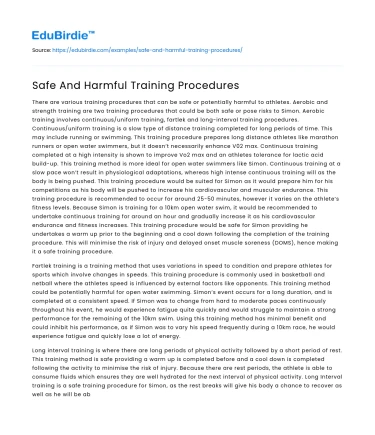There are various training procedures that can be safe or potentially harmful to athletes. Aerobic and strength training are two training procedures that could be both safe or pose risks to Simon. Aerobic training involves continuous/uniform training, fartlek and long-interval training procedures. Continuous/uniform training is a slow type of distance training completed for long periods of time. This may include running or swimming. This training procedure prepares long distance athletes like marathon runners or open water swimmers, but it doesn’t necessarily enhance V02 max. Continuous training completed at a high intensity is shown to improve Vo2 max and an athletes tolerance for lactic acid build-up. This training method is more ideal for open water swimmers like Simon. Continuous training at a slow pace won’t result in physiological adaptations, whereas high intense continuous training will as the body is being pushed. This training procedure would be suited for Simon as it would prepare him for his competitions as his body will be pushed to increase his cardiovascular and muscular endurance. This training procedure is recommended to occur for around 25-50 minutes, however it varies on the athlete’s fitness levels. Because Simon is training for a 10km open water swim, it would be recommended to undertake continuous training for around an hour and gradually increase it as his cardiovascular endurance and fitness increases. This training procedure would be safe for Simon providing he undertakes a warm up prior to the beginning and a cool down following the completion of the training procedure. This will minimise the risk of injury and delayed onset muscle soreness (DOMS), hence making it a safe training procedure.
Fartlek training is a training method that uses variations in speed to condition and prepare athletes for sports which involve changes in speeds. This training procedure is commonly used in basketball and netball where the athletes speed is influenced by external factors like opponents. This training method could be potentially harmful for open water swimming. Simon’s event occurs for a long duration, and is completed at a consistent speed. If Simon was to change from hard to moderate paces continuously throughout his event, he would experience fatigue quite quickly and would struggle to maintain a strong performance for the remaining of the 10km swim. Using this training method has minimal benefit and could inhibit his performance, as if Simon was to vary his speed frequently during a 10km race, he would experience fatigue and quickly lose a lot of energy.
Save your time!
We can take care of your essay
- Proper editing and formatting
- Free revision, title page, and bibliography
- Flexible prices and money-back guarantee
Long interval training is where there are long periods of physical activity followed by a short period of rest. This training method is safe providing a warm up is completed before and a cool down is completed following the activity to minimise the risk of injury. Because there are rest periods, the athlete is able to consume fluids which ensures they are well hydrated for the next interval of physical activity. Long Interval training is a safe training procedure for Simon, as the rest breaks will give his body a chance to recover as well as he will be able to consume fluids and stay hydrated.
Strength training is comprised of resistance, weight and isometric training methods. This is generally a safe method of training providing muscles are given 48 hours to rest and recover.
Resistance training is a safe training procedure providing the resistance is not excessive. If athletes are using too much resistance, they can be more susceptible to soft tissue injuries. For Simon, resistance training is a safe training procedure as the resistance in elastic bands is limited. Hydraulic machines are also safe to use by Simon as he can adjust the resistance he is pulling each time and can stop if he needs to. Weight training can be a potentially harmful training procedure. Lifting heavy weights can cause injury. It’s important that Simon has a spotter when he is undergoing weight training to not only spot him but also let him know to adjust his technique if needed, as it’s easy to undertake weight training with incorrect and poor technique. Simon needs to allow at least 48 hours between weight training sessions in order to prevent overuse injuries and cause harm to his body.
Therefore, Weight training can be a harmful training procedure for athletes if they don’t take necessary precautions like having a spotter or give their bodies enough recovery time.
Isometric training is considered a safe training procedure and is where muscles are under tension, however, they don’t shorten or lengthen. Isometric training may involve holding plank or push up positions. These body weight exercises are safe providing the athlete uses the correct technique. To enhance the safety of isometric training, Simon could have a Personal Trainer supervise him during this training to let him know if he needs to adjust his technique in order to minimise the risk of injury and harm to his body.






 Stuck on your essay?
Stuck on your essay?

